What to Do Now: Advice for Personal Trainers
by Dan John, Master RKC
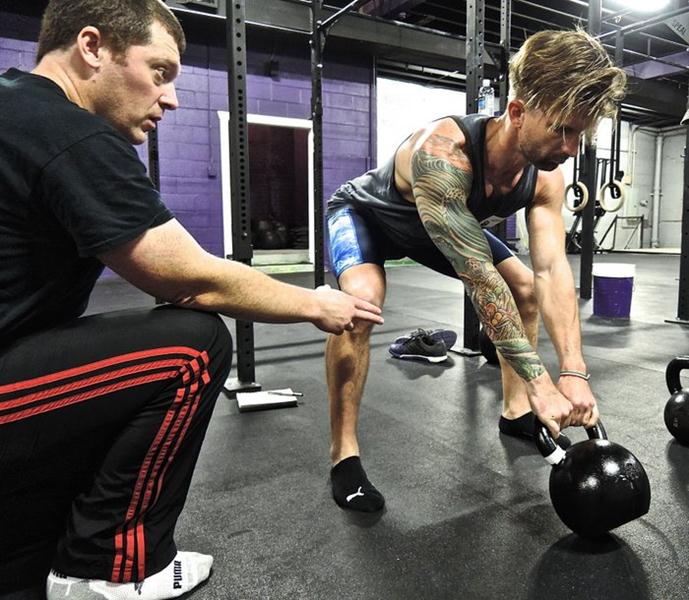
One of our local sports talk stations plays an ad for becoming a personal trainer. The ad also guarantees work within six months of completion of the course. Now, I’m waiting for a company to come out with a quick course on dentistry, so I can start work as a dentist. Volunteers?
Personal training is an exploding field and, sadly, few people survive the first year. You might have the body and the knowledge, but the "Body of Knowledge" in the fields of health, fitness and performance will overwhelm you. Moreover, your clients will seem to go out of their way to sabotage their own success.
Recently, I told someone to put this sentence on her business card: "Getting you to do what you asked me to get you to do."
Talking with clients demands some knowledge, some insights, and some tools. You need to ask the right questions, use some simple assessments, focus on the basics, and work your way forward with steady steps in movement.
Let’s begin. Here are my mistakes and my journey…
The Ten Key Questions! Wait, the Five…I mean, the Three!
I was joking with another fitness writer not long ago that they need to stop working on books and articles because, otherwise, they will continue to cut, trim and slash back the material until all that’s left is a sentence or two.
The great interchange between Thoreau and Emerson comes to mind:
"Simplify, simplify" said Thoreau.
"You didn’t need the second ‘simplify’," answered Emerson.
My book,
Intervention, was based on ten questions for athletes followed by five strength training principles. After years of teaching and doing the
Intervention protocol, I only have two strength training principles now:
Principle One: Mastery of the basic human movements trumps everything else for lean body mass quality and joint mobility.
Principle Two: Standards and gaps must be constantly assessed—in a REASONABLE approach.
I also have an overarching general training principle:
It’s fine if we don’t know how it works, if it works. Remember, we must follow the evidence, no matter where it leads.
Many coaches and trainers have an odd problem that my good friend, Sherlock Holmes, once noted in "A Scandal in Bohemia" when he said, "You see, but you do not observe." Once I began my full-time coaching career in the fall of 1979, I have been guilty of every mistake that plagues all of us in the field of fitness and strength:
- I counted reps out loud for the lifter.
- I immediately tried things that I read in a book or magazine.
- I tried to pound square pegs into round holes.
To be honest, each one of these mistakes also has merits. There comes a time—like on a bodyweight back squat death march—when the lifter is totally focused on "just one more rep" while on the way to fifty. If he or she can’t remember how to count past thirty, then each of the above "mistakes" above might NOT be a mistake.
Fortunately, I was never fired for my early efforts as a coach. That might be the upside of volunteering as a strength coach: no matter how awful I was, I was still inexpensive! I tried out a variety of ideas, concepts, and idiocy on my athletes and took volumes of notes. I found I could chart success for throwers by simply have them throw a lot and get strong in all the basic movements. With football and wrestling, it was difficult to see the impact of the weightroom, but it certainly seemed to help. I had to literally observe more.
As my coaching experience wound through the second decade, I began noticing that certain principles—and the answers to certain questions—seemed far more important than all the new, shiny ideas in magazines and, later, the Internet. Soon, my interns, assistants and peers began to ask the same question:
"How do you do it?"
Do what?
"Well, I’ve been here for a few weeks. I’ve watched you answer the phone and give some advice. I recognize the bulk of it, but then BOOM, you toss in all this other stuff we do and add a point I have never heard. How do you do it?"
It took me the better part of four years to reverse engineer my brain and come up the answer. The answer first appeared in
Easy Strength. As I continued to rethink and relearn the lessons of coaching, I began to realize that I had a toolkit to cut through all the crap and nonsense to get an athlete into a position to use the weightroom to support their goals.
Why do I call it
Intervention? Well, it is funny because it seems like what you see on the TV show. Here is an example:
If you show up to work with me at age 13, I will teach you to tumble, Olympic lift, powerlift, work with
kettlebells. I will teach you practically every variation of every move I can think of during training. Over eight years, we will hone and refine this as we get you closer and closer to your goals.
But if you’re not 13, and have X and Y and Z, then you need an intervention! The original program of
Intervention is based on ten questions and five principles. The questions are as simple, "What’s your goal?" and "How old are you?" Those two points alone are a gold mine of information.
I can’t tell you how often I work with someone in their 30s, 40s or 50s who think they should train like a Navy SEAL or a NFL football player. They say, "Hey, I saw this guy on TV and he was doing…"
Shut UP!
If you are not in the Navy (or Coast Guard) and not currently playing college football, you need to listen to me: you are NOT in the Navy or on a college football team. Train your age. Train for your goals. Be reasonable! As my old coach, Ralph Maughan, used to say "Be reasonable. Do it my way."
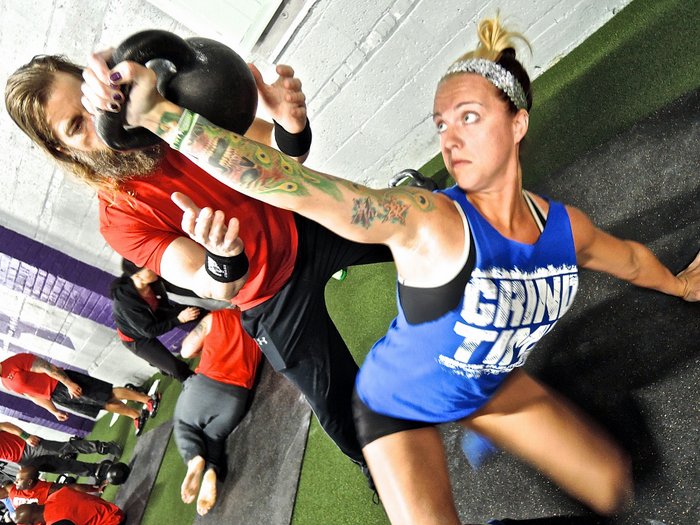
Now, the whole process I used to use for Intervention is simply three questions:
- What’s your goal?
- Will this goal mostly improve your life?
- How old are you?
I eliminated some of the other key pieces, but let’s look at the two questions which are important but get "dismissed" in a reasonable approach. Obviously, we would talk about these things throughout our discussions and training:
- Is this a health or fitness goal?
- What quadrant is your goal in?
The discussion about a goal being either for health or fitness still has value, but, after high school, college, or a post-collegiate athletic career, most people realize that a
fitness goal should lead to better health. It may seem obvious, but some people can’t get this straight. Health is the optimal interplay of the organs, and fitness is the ability to do a task.
Recently, I gave a workshop. In a review, the host disagreed with my definition of fitness. In a blog, he noted a popular definition that has been around for about a decade. The word "fitness" has deeper roots. It is probably from the Old Nordic word meaning "to knit", and frankly, I can’t think of a better way to define a "fit person". If you have fame and a lot of money, but are a horrible drunk, your spouse left you, and you have no contact with your four kids, that defines "unknitted" to me.
"The state or condition of being fit; suitability or appropriateness" is one standard definition of fitness. I like the concept of appropriateness in constructing any training model for any goal. If you really want to lose body fat:
- Get tied to a tree for three days. (A professor friend of mine GUARANTEES success on this!)
- Survive an apocalyptic event and wander around with your child. (See The Road.)
- Survive a plane crash and live on an island by yourself. (See Castaway.)
But, these "solutions" lack the nice little insight of appropriateness! Listen—shema is the powerful way to say "listen up and hear this" in Hebrew—I have nothing against hard core, serious, top-end, pedal to the metal training. It is just so difficult for most people to combine that kind of training with a real life. If you are a high school kid or still living with mom, then this all great and fine. But, it is NOT the same as the more common situation of a person who is juggling a career and a family who might be interested in getting a bit leaner and living a bit better longer. We need to be appropriate. And we need to be reasonable.
This is a list of ten basic health tips that I think we should all follow. Most of the list is pretty obvious, but stats back up the list too!
- Don’t smoke.
- Wear a seatbelt, and a helmet when appropriate. Technology can get you faster than your skull can grow thicker.
- Learn to fall and recover. Maffetone notes that 28,000 Americans die from falls and fall-related deaths.
- Floss your teeth! The healthiest thing you can do for your heart is to floss your teeth!
- Eat more protein.
- Eat more fiber (mostly from veggies)
- Take more fish oil.
- Drink more water.
- Build more lean body mass.
- Keep your joints healthy, and maintain joint mobility.
Rules Nine and Ten are the foundation of my work in the weightroom. The other eight are up to you!
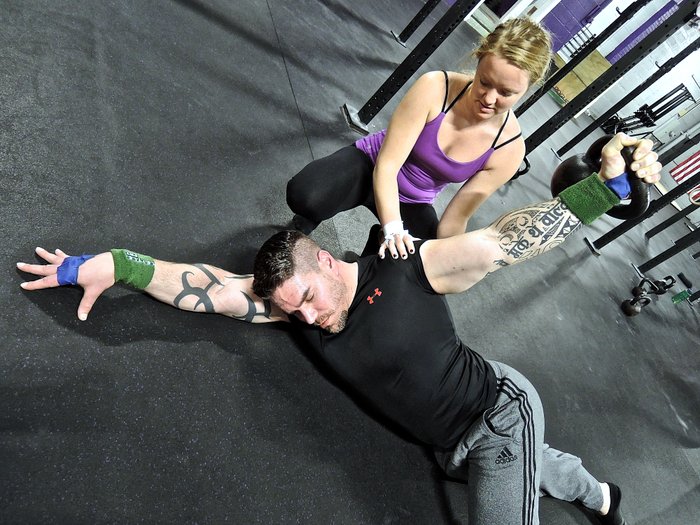
In
Easy Strength, I outlined the Quadrants—it was my attempt to answer a very good question, "What is the impact of the strength coach?" My original answer, "It depends," was very good but not very enlightening. With some time and effort, I came up with the simple image of four quadrants that depend on the number of qualities a goal requires, and the relationship goal has to the absolute highest levels of human performance. There may be many qualities required for football, but for shot put, there are only two: get strong and throw the shot. Either way, it is impossible to train for elite sprinting and elite swimming at the same time.
Here are the basics of each quadrant:
Quadrant One
The person in this quadrant is learning a lot of qualities at a low level, like a high school physical education class. Most people only get one shot in life for this quadrant. This is why the importance of a quality PE program can’t be overemphasized. Here we learn the rules, skills, and the appreciation of games, sports and movement.
Quadrant Two
This quadrant houses the collision sports and occupations. A lot of qualities are needed, and at an amazingly high level. This is football, rugby and Special Forces work. Sadly, most people plan to train in this quadrant, yet few
should train in this manner.
Quadrant Three
This will sound odd, but here there’s a need for a few qualities at a low level. Most people fit in quadrant three, but elite athletes are most often found here, too. An elite track athlete needs technique and strength. The strength levels are amazing, but are not high when compared to an elite Olympic lifter. In this quadrant, a person may need the absolute strength to deadlift 600 pounds. That’s a pretty big number, but let’s remember the world record is nearly twice that. In this quadrant, it’s all relative.
Quadrant Four
In quadrant four, we find the rarest of athletes. These are people who need very few qualities, but need to perform at the highest levels of human performance. Examples include 100-meter sprinters and Olympic lifters. Unless you are thinking of deadlifting 1,000 pounds or sprinting a 9.8 100-meter, you might not be here.
Life and Living in the Quadrants
Almost universally, when I walk people through these questions, I tell them they’re in Quadrant Three. It’s not laziness, it’s reality. Sure, an NFL player
was in Quadrant Two, but as a career moves on, training simplifies.
In fact, part of my "sad, but true" talk for nearly everyone I’ve walked through this program is this: you are not in high school or college anymore! And, that’s probably a good thing. It’s now time to work on the two big things: hypertrophy—as lean body mass increases, there’s less fat and more muscle—and joint mobility.
The toolkit I will use to get you back to your fitness goals is again based on the two principles of strength coaching:
Principle One: Mastery of the basic human movements trumps everything else for lean body mass quality and joint mobility.
Principle Two: Standards and gaps must be constantly assessed…in a REASONABLE approach.
But first, we need to
assess. With any goal, the road is simply from A to B. "B" is where you are going, the goal that you want to achieve. First and foremost, we must find out where you are today. I am now using three (actually four, but you will see the point in a moment) simple tests that take under five minutes to perform, yet the results speak volumes about where you are right now (A). Sure, I also use the
FMS test, strength tests, jumping tests and all kinds of other assessments with many people, but I can get the same basic information from the three simple tests that I will explain below.
The first and simplest test requires a measuring tape. First, how tall are you? Second, what is your waist measurement? Dr. Margaret Ashwell said, "Keeping your waist circumference to less than half your height can help increase life expectancy for every person in the world." Dr. Ashwell is an independent consultant and former science director of the British Nutrition Foundation. She presented these findings at the 19th Congress on Obesity in Lyon, France. Brad Pilon, author of
Eat Stop Eat, discusses this issue at length in his work,
Dieting for Muscle Growth. He takes it a step further and notes that if you are over the one-half measure on your waist (in regards to height), you might be suffering from a variety of inflammation issues.
If you are over that number, whatever you do to reduce your waist circumference will be better for you. Another conclusion from Ashwell’s talk was simply, that in terms of cardiometabolic risk, abdominal fat affects organs like the heart, liver and kidneys more adversely than fat around the hips and bottom.
That’s good enough for me and the test is so simple, fast, and easy to explain, that it is worthy of instant adoption. So, if the waist to height ratio is great than 1 to 2, address it by any means possible.
The second easy assessment comes from Stu McGill, the great back expert from Canada. I am a big fan of all his work and always sit in the front row when he speaks. His test is very simple:
Can you do a two-minute plank? Not 2:01, but two minutes? No? Well, then that is an issue! Stu tells us that either you are training your core poorly or you are obese. That’s why I love Stu’s work, he uses his research facility to bring clarity into my training gym.
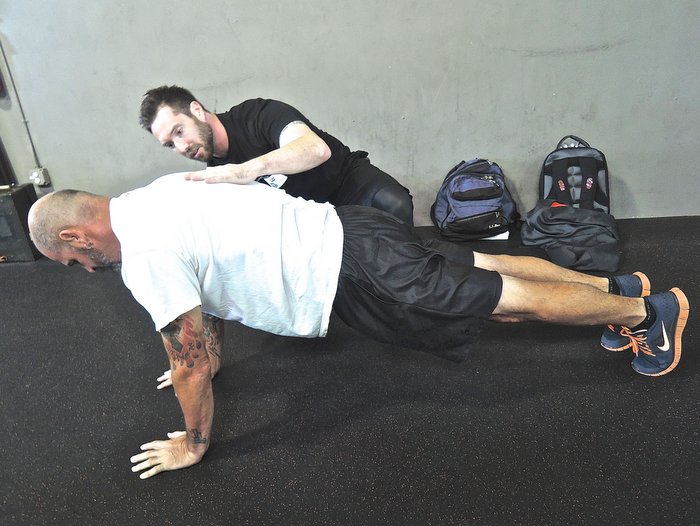
One funny thing: I can get a very high fail rate by waiting the full 60 seconds of the first minute before saying, "Half way." That groan and that feeling of "no way!" leads to people dropping out very often. So, it often takes a few attempts to mentally prepare the person for a two-minute challenge.
Both tests, the height to waist ratio and the two-minute plank challenge will take (at most) three minutes.
The third assessment is so simple that it’s easy to completely miss the point:
Get on the ground in a seated position, now stand up. That’s the whole test!
Dr. Claudio Gil Araújo, performed a study at Clinimex-Exercise Medicine Clinic in Rio de Janeiro, said this test is "remarkably predictive" of physical strength, flexibility and co-ordination at a range of ages. He added, "If a middle-aged or older man or woman can sit and rise from the floor using just one hand—or even better, without the help of a hand—they are in the higher quartile of musculo-skeletal fitness, and their survival prognosis is probably better".
The test is simple. Tell the participant the following: Without worrying about the speed of movement, try to sit and then to rise from the floor, using the minimum support that you believe you need.
Each of the two basic movements were assessed (getting down to the ground and back to standing) and scored out of five for a composite score of ten. One point is subtracted from five for each support—like a hand or knee—that was used.
Here is the interesting part, those who scored three points or fewer had a five to six-time higher risk of death than those who scored more than eight points. A score below eight was linked with two to fivefold higher death rate over the 6.3-year study period.
Doctor Araújo’s study also showed that maintaining high levels of body flexibility, muscle strength, power-to-body weight ratio, and coordination were not only good for performing daily activities but have a favorable influence on life expectancy.
So, here are our three tests:
- The height to waist ratio (2:1) test
- The two-minute plank test
- The "sit then stand" test
I usually add one more additional test. Clarence Bass, of
Ripped fame, offers a simple metric—you should be able to stand on one foot (test both, obviously) for ten to twenty seconds. After twenty seconds, I usually joke that it is just "a circus trick," but here is the interesting thing:
If you can’t stand on one foot for at least ten seconds, then as Bass notes, there is something wrong with you. When my hip became necrotic—on the list of bad things to hear about your body, "You have a necrotic hip" is very bad—I could no longer could stand on one leg. I could no longer even stand on my GOOD leg!
So, it’s a fun test and something worth doing when you are standing in line for a movie or while doing a chore. Does it have the same value as the other three tests? Well, who knows, but it takes only a few seconds, and might be challenging enough to get someone excited about improving all areas of their training.
These three or four tests also give me a moment to address, usually inside my head, where this person fits within a simple series of terms:
Untrained: Often the "best," because untrained people often don’t carry a lot of baggage from poor training programs, overtraining issues and additional information they may not need. With untrained people, corrective work is often simply teaching them the techniques of training and performing the fundamental human movements since they might not have many injuries.
Detrained: Ask any trainer or coach, and you’ll hear that these are often the worst. The more "I used to…" stories you hear, the harder the road ahead. If this person has tried thirty diets or ways of eating, any nutritional advice you give is attempt thirty-one. Get ready for plenty of "I used to this," "my coach used to have me do that," and stories of former glory.
Over and Under: Over-conditioned and undertrained. This person has learned ten thousand different ways to do the most elaborate and difficult moves in every sport and gym movement, but can’t seem to do five push ups. These are the same people who tend to raise their hands all the time at my workshops, but can’t do the first minute of the warm up. If you train or coach people, you know them! This is relatively new, but very hard working person who will always demand to puke and sweat before labeling a workout as "good." Often, though, their poor technique and lack of mastering the fundamental human movements make them painful to watch. It will take a lot of convincing to change their minds that for long term, there is a better way to do it.
Dazed and Confused: This is the big group of people who are convinced that fruit makes them fat…or is it coffee? Lifting makes you weak and stiff, but running is good and bad. Whenever I read a fitness magazine, I feel this way, too.
Well Trained: This person seeks
mastery, appreciates the highs and lows of daily, weekly, monthly (and even decades of) training. They always want something larger, even if it is tough to define. Yes, I wish everyone who walked into the gym was like this!
Almost universally, the following mantra can be used to help all of our friends, from the untrained to the well trained:
Regressions are the best corrections.
Memorize that phrase. Even though you can do all kinds of really interesting flexibility, mobility and voodoo movements, ultimately, the simple regressions of the basic human movements will be your answer to progression.
Regression leads to progression when working with the human body. I’m reminded of the wisdom of my high school math instructor who began the year with the final from the previous semester. We all bombed it. Then he said, "Well, usually I don’t do this, but let’s spend a week reviewing Geometry (or Algebra or whatever it was)." The next year, I wasn’t so surprised to hear him repeat the exact same process.
Regressions also seem to ease the "flight or fight" response humans have in an uncomfortable position. Moving too far into challenging movements seems to make the rest of the body tense and shrink in—the neck ducks down, shoulders rise up and cave over, the back rounds and, well, we turn into Gollum. Gollum is not a good image for human posture, my precious.
I have been looking at the regressions of the fundamental human movements in a very simple way:
"No Movement" to "Slow Movement" to "Asymmetrical Movement" to "Ballistic Movement"
"No movement" establishes the position and the pattern. I think most people get away from the basic move most of us call "planks" too quickly. A plank is just like a piece of wood might use for building a deck, or for walking down because of some transgression against Captain Hook.
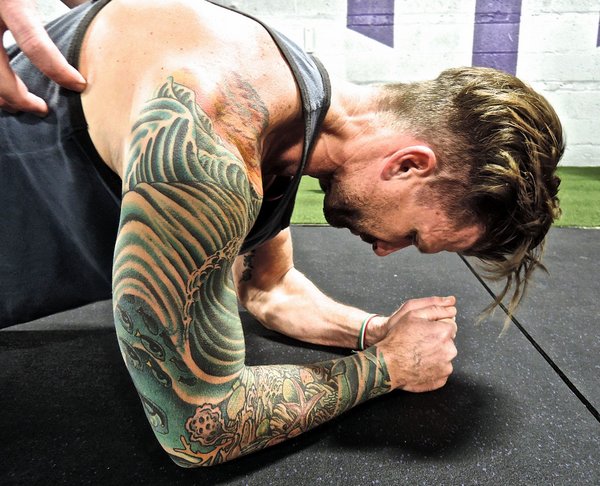
When performing planks, you want to hold your body so that we could walk across you. The plank is also something that we will return to when discussing actual movement. This is because you will also need to learn to tense your body as rigidly as possible during almost all strength exercises.
Tension and relaxation live in a yin-yang relationship in performance. The best way to understand this is to snap your fingers. Sure, you can squeeze harder, but to snap, you have to release your finger. Slamming your middle finger into your thumb pad won’t make a sound; you have to snap it.
Planks teach the tension side. Learning to tighten instantly and loosen instantly is the target of elite performance. Recently, a pilot told me that when you first learn to fly, you have two bags. You have a bag of luck and a bag of experience. You want to make sure that you don’t empty luck before you fill your bag of experience. He also said—and this is just something to remember—landing is mandatory, but taking off is optional. This is a message for all of us.
Like luck and experience, tension and relation are two bags you want to keep fairly full.
I now believe that planks can even be used as an entire training program as in the example below:
- Planks (either on the elbows or in a push up position)
- Pelvic Tilt/Hip Thrust
- Goblet Squat
- Suitcase Carry (The Suitcase Carry is a walking plank!)
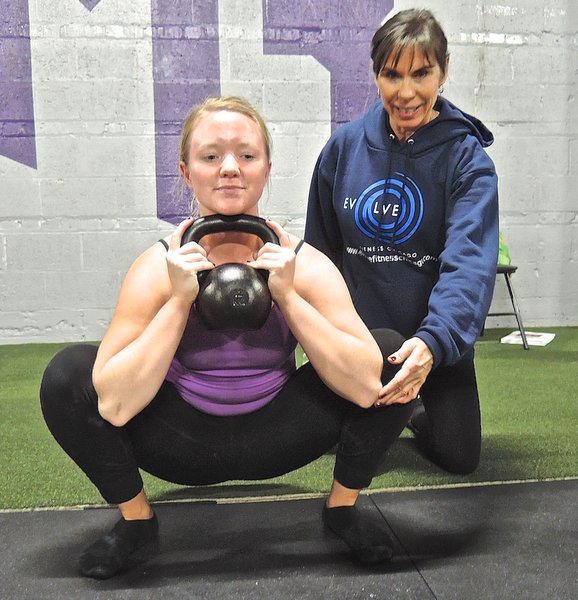
For a "workout" consider this:
A two-minute plank
Then, a "workout" with the following:
25 Pelvic Tilts
10 Goblet Squats
Suitcase Carry a weight for 10 meters.
Repeat as many times as appropriate.
Note: Did you notice how you get on and off the ground a couple of times? That’s your "get-up!"
PUPPs are the "Push Up Position Plank" and those of us who train both women and untrained and detrained men have found this to be an ideal way to build up the isometric push and establish a degree of rotary stability. Rotary stability is simply the body’s means of stiffening up and stopping twists or turns—a good thing in a collision.
Since meeting Chip Conrad, I have added a few hints to PUPPs and all other plank variations. First, I like the legs and feet together and squeezing in. Slide some paper between the knees and don’t let it go. Chip adds, "Squeeze the troll’s heads that are inside your armpits." Personally, this single clue has done more for my coaching than anything else in the last year. As you squeeze, make sure the whole pad of your palm is on the ground. The index finger pad of the palm often comes up for men with shoulder issues. Twist the hands to get the correct position: index finger pad of the palm on the ground. Now, hold it.
Pelvic Tilts. When I was in Canada, a woman raised her hand and insisted that I call these "Supine Bridges." I wanted to explain that in the States, "Sue pines on bridges" is the start of a Country and Western song, but I digress. In the 1970s, the aerobic craze did these along with Fire Hydrants. In 1984, Irving Dardik recommended them as a core movement to make a quantum leap in training. Today this same movement is noted as a great hip flexor stretch and butt builder.
The Goblet Squat. Grab a kettlebell and hold it by the horn, like you're holding a goblet against your chest. Hence the name, "goblet squats."
Read Mike Krivka’s great article for any nuances!
Suitcase Carries. Generally, I first teach farmer walks, as most of the lessons from them happen in the first ten seconds. Cues like big chest, shoulders back, "head on straight" and "walk the line", are all natural and simple to teach. But, suitcase carries have a special place in my evil heart. These literally are walking planks and you will discover your obliques the day after you first learn them. It’s simple, pick up something in one hand, keep the other hand empty, and walk as far as you can. Switch hands and come home. Hey, you’re home!
This series of simple moves can be excellent for road warriors who travel every week and find little in the way of training facilities. These moves are also great for detrained athletes who need to "wake up the echoes", or the untrained who are exploring their bodies for the first time.
This minimalist program involves a lot work, very little equipment, and very little actual movement. It can leave you sore, sweaty and insightful. The areas which are sore the next day are clues to issues that might be haunting you. This is pretty close to my ultimate regression workout, but we can go a few steps further back, too.
Recently, on a beach in Hawaii, I had a group of elite Navy personnel doing pelvic tilts/hip thrusts for sets of 25 reps. The next day, the head of the group told me, "From now on, I’m doing these. Alone. But, I am doing these." This movement is a "one stop shop" for stretching your hip flexors, building the butt, and providing insights on how you’re cheating on your butt work.
If you come up on your toes or lift your head, why? The answer for me was that I had Janda’s famed "gluteal amnesia" and had to get on the ground and squeeze my cheeks together. Under load, you certainly may call these movements, "hip thrusts" and I am very interested in the work of Bret Contreras and Nick Horton. They’ve shown people the value of this movement not only for show but for go. Nick’s Olympic lifters are using the hip thrust as a basic training move and making great progress.
So, don’t discount any regression. Use each and every one you can in general warm ups, or—what I prefer—during rest periods of other movements. It will keep the heart rate up and things going well for you.
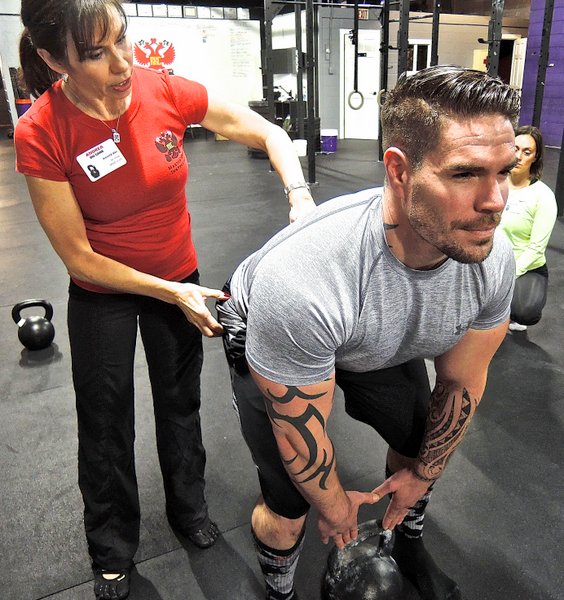
Regressions: The Best Corrections
To begin the process of goal achievement in fitness, I ask three questions:
- What’s your goal?
- Will this goal mostly improve life?
- How old are you?
You know that you can serve both health and fitness with your training approach and that you are in Quadrant III. So, we don’t have to go into much more detail except to ask anyone you train (or yourself) over and over, "Did you floss today?"
We took the three assessments (and, perhaps adding the standing on one foot test as a fourth assessment):
- The height to waist ratio (2:1) test
- The two-minute plank test
- The "sit then stand" test
During the tests, we mentally plugged the person (or yourself) into these categories:
- Untrained
- Detrained
- Over and Under
- Dazed and Confused
- Well Trained
Frankly, the "Planks as a Program" workout will well-serve most people. It will give me great joy to see the three assessments improve while doing this simple approach each month.
From "Best to Worst," you might observe this:
All five well trained people on planet Earth will follow your ideas exactly and understand this is part of the journey.
Untrained people will be like puppies and you will be loved. Every little physical change from physique to feelings will be shared with joy.
Dazed and confused people will bring in tons of magazines, books, websites and information from their friend’s friend about this "really good idea" that "everybody is doing." March on, little soldier!
Detrained and "over and under" people will be wondering why they see "absolutely no progress, because when I used…" Fire them. Seriously. If you are a coach or fitness professional, save yourself the time, effort and sanity and fire them. You will sleep better and be happier. We need the Zen concept of Beginner’s Mind when it comes to repairing either years of sloth or idiocy. I don’t have enough time left on this planet to deal with this kind of thing. Fire them.
If you are kind and choose not to fire them, I would ask that you demand total adherence to mastery and simplicity.
I would love to give global advice about what to do next, but it is nearly impossible. As I have come to discover, I might have an NFL lineman doing goblet squats with
53 pounds prepping for the season, while over against the wall I might be yelling encouragement for a 14-year-old boy to front squat 205 for the first time. Proper reasonable training is all about finding where people are and striving forward towards improvement. You might never find the best thing to do in any aspect of your life, but you should strive for optimal, solid, or simply "pretty good." Pretty good is still pretty good. You will never find the best or perfect in every aspect of life.
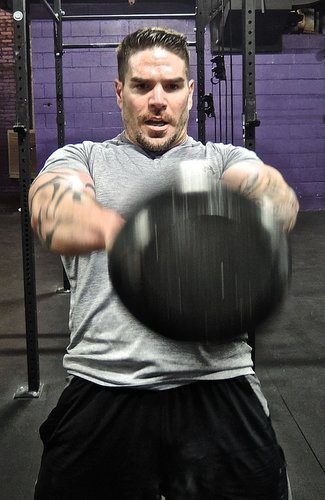
Using these various questions have helped me circle around some basic insights. First, many people come to me with massive gaps in their training program. Simply, the first step is to discover the gaps in their training.
I believe in fundamental human movements and use this list:
- Push
- Pull
- Hinge
- Squat
- Loaded Carry
- The Sixth Movement (everything else, but usually it is ground work and throwing things)
For most people, adding a goblet squat and a farmers walk to their "bench press, curl and lat pull-down" training makes me a miracle worker in just about three weeks. So first, we address the gaps in training.
Next, some people do all the basic movements, but at to low of a level to impact performance or body composition. If you wear a sparkling tank top while you train, and clap your hands and say "wooo!" a lot, this might be your issue—or you have an imbalance between an overwhelming performance in one move and mediocrity in another. I was the poster boy for coming out of high school with a bench press that startled adults, but I was unable to squat with a cup of coffee. When I addressed that issue, it changed my career in about six weeks.
By the addressing gaps and standards after washing the goal through some basic questions, we can point to our approach for training over the next few weeks or months. At the same time, I will also begin to ask you to step up your performance during most training sessions, but in a way that few think about… I will ask you to move beautifully. I want to see grace and elegance in your movements both in training and in life. I want to push you towards mastery.
As I tell my students, "Your life is your message." Flailing to just get it done in training will impact your relationships with your spouse, your children and your community. Mastery of the fundamental human movements with appropriate load is the fastest road to most basic fitness goals.
I’m just skimming the basics here, but here are a few things you can do right now. Chip Conrad considers the three basic movements to be:
He then adds a beautiful insight, "And the flow between them." Everyone can use a refresher course on "flowing," but let me give you three healthy hints to make your life a bit "fitter."
- Sure, I would love to see most people cut out or cut back television, but try a technique I have been using lately: sit on the floor and watch TV. It’s simple and free. I found that I can’t sit and watch TV on the floor! I move, stretch, change positions, toss around, and I get up and do things. Basically, I think most of us need more time on the ground doing things, and this is the cheapest advice I can give.
- When you stand, try to make your belt line parallel to the floor. To do this, squeeze down your butt cheeks. By making the "bowl" of the pelvic floor not "spill water", you are line up the posture and may discover a few things about how your body has been misaligned. Note this: if the front of your hips are tight when you squeeze the butt, you might need some basic flexibility work on the hips and some butt (glute) work. In fact, I know you do.
- Finally, crawl around a bit. Yes, I am encouraging you spend more time on your hands to get around. I love push ups for most of my people, but I also love the dozens or so crawling and all fours variations. If you don’t have the space, get in the up part of the push up position and just move your hands around in alternative directions. It’s that simple.
The flow between the movements can actually be a great workout. I shared this idea a few weeks ago and had one person take my advice. Start by lying on the ground. Then, stand up, squeeze your cheeks, then go back to the ground. Repeat this for five minutes. My one "volunteer" emailed to tell me that his heart had gone through the roof doing this. Yes, it can be this inexpensive, simple and basic to begin.
Intervention is simply this: I need to convince you that you are right here, right now. You are at age X and you need to train considering your age, your experiences, and towards your goal. You are here and we are going to go there, but let’s remember where "here" is, okay?
Someone always raises their hand at this point to ask, "Well, after we do all of this, what should we do next?"
If you
read my last piece, you should know:
Swings
Goblet Squats
Turkish Get-Ups!
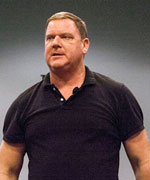 Dan John is the author of numerous fitness titles including the best selling
Dan John is the author of numerous fitness titles including the best selling Never Let Go
and Easy Strength.
Dan has spent his life with one foot in the world of lifting and throwing, and the other foot in academia. An All-American discus thrower, Dan has also competed at the highest levels of Olympic lifting, Highland Games and the Weight Pentathlon, an event in which he holds the American record.
Dan spends his work life blending weekly workshops and lectures with full-time writing, and is also an online religious studies instructor for Columbia College of Missouri. As a Fulbright Scholar, he toured the Middle East exploring the foundations of religious education systems. For more information visit: http://danjohn.net
Back